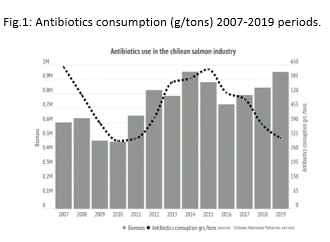REDUCING THE USE AND IMPACT OF ANTIBIOTICS IN AQUACULTURE: THE COLLABORATIVE EXPERIENCE OF THE CHILEAN SALMON INDUSTRY
With exports of over 550,000 tons in 2018, salmon farming in Chile is one of the most important economic activities, accounting for 7% of the country’s total exports. The rapid growth of the industry during the 1980s allowed the consolidation in international markets, with Chile becoming the world’s second-largest supplier of farmed salmon.
Despite continuous remodeling and reorganization of the salmon production system, during and after the pandemic ISA virus crisis, health and environmental challenges remain. The bacterial disease, Salmon rickettsia septicemia (SRS), results in annual losses, environmental impacts, and market externalities. Given the complex biology of the bacteria, there are few preventive measures and tools to control outbreaks. The primary tool for the control of an SRS outbreak is antibiotic treatment.Several complexities exist regarding antibiotic use in aquaculture, including, efficient use, logistics, and operational use. In addition, concerns and uncertainties exist about antibiotic impacts on the water column and seabed, despite its heavily regulated use in Chilean
During 2019, SalmonChile and the Monterey Bay Aquarium Seafood Watch (SFW) signed a collaboration memorandum to improve the environmental sustainability of the Chilean salmon industry. One of the key objectives of this partnership is a 50% reduction or antibiotic use by 2025. This program was launched as the Chilean salmon antibiotic reduction program (CSARP).
As a result, the program has identified indicators, recommendations, and research gaps to meet the objective of the program. In addition, the programs technical advisors have identified specific metrics and actions for monitoring, reporting, and transparency of the process.
CSARP is one of the most important private and voluntary initiatives for reducing the use of antibiotics in animal production, including aquaculture. The program members include 16 salmon farming companies, equivalent to 100% of Atlantic salmon production, the Chilean salmon farmer association, the Chilean salmon marketing council, and the Monterey Bay Aquarium Seafood Watch Program.
